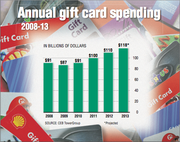Gift cards, viewed by some as impersonal and thoughtless, have become a retail fixture, with gift-card spending expected to reach an all-time high this Christmas.
While retail sales are expected to be weak this year, eight in 10 customers will buy gift cards for their friends and relatives for Christmas, according to a survey by the National Retail Federation.
“Gift cards are popular gifts every year because they’re personal and practical and attractive to all ages,” said Kathy Grannis, spokesman for the federation in an emailed statement.
“Particularly in this economy, gift cards are in high demand; shoppers give gift cards so their loved ones can purchase whatever items they’ve been wanting but maybe haven’t been able to afford.”
Individual shoppers are expected to spend an average of $163.16 on gift cards, up 4 percent from the $156.86 spent in 2012, according to news release from the federation earlier this year.
Total spending on gift cards will reach about $29.8 billion this Christmas, compared with $28.79 billion last year, according to the retail group.
Retail sales overall in November and December are expected to increase only 3.9 percent to $602.1 billion, according to the forecast the federation released in October.
The rise in gift-card sales this year is part of an upward trend, said Brian Riley, senior research director for CEB TowerGroup, which predicts that gift-card purchases will account for 18 percent of Christmas spending by 2015.
“There are more teenagers who have gift cards than acne,” Riley said.
Gift cards can be used at restaurants and other services, but are most popular for retail stores, he said.
CEB TowerGroup expects gift cards to bring in a total of $118 billion for the entire year, up from almost 8 percent from 2012.
About 40 percent of purchases of gift cards are made during November and December, Riley said.
While gift cards are becoming more popular, some people still view them as impersonal and worry about cards losing value if they aren’t used immediately after they are received.
This year about $1 billion in gift cards will go unredeemed, that’s down from $1.7 billion last year.
“When [gift cards] first came out, there was a little bit of stigma to it, but now they are so common,” Riley said. “Being able to have the selection to it, makes it more personal.”
Linda Hay, the manager at Tulips, said the Little Rock boutique helps personalize the gift cards it sells by wrapping them like presents.
Hay, whose daughter owns Tulips, said she thinks gift cards are now more common as gifts because “people are always in a hurry.”
But some shoppers are still hesitant to buy gift cards.
“I’d rather give a gift because I know I’d rather receive a gift someone put a lot of thought into,” said Sherry Glover, 49, of Pine Bluff while shopping at Park Plaza in Little Rock.
“It’s more personal,” said Glover’s friend, Ayn Freygang, 60, about preferring presents over gift cards.
Stephanie Dyer, 39, of Little Rock who was shopping separately at Park Plaza, said she normally buys gift cards for friends and relatives who are teenagers or in college.
“They are hard to buy for… and they don’t have a lot of money,” she said. “People have so much stuff. I’d rather people get what they want rather than give them something they don’t need.”
Dyer said this year she bought a Sephora gift card for a cousin, a Bass Pro Shops gift card for a neighbor and a Target gift card for another cousin.
As the sale of traditional gift cards has increased, so has the use of digital gift cards, Riley said.
CEB TowerGroup expects “e-gifting” to bring in $4 billion this year.
“They are starting to take hold,” he said. “It’s a relatively short-lived industry. It has a lot of opportunity in front of it.”
Shoppers can buy digital gift cards online from a retailer’s website or on websites such as giftcardmall. com, which sells cards from different stores. The cards are then delivered via email or traditional mail to the recipients.
Riley said digital gift cards make it easier to send a person a present and can’t be lost like a traditional card.
“There’s definitely a shift in the market towards more electronic forms,” he said.
Business, Pages 71 on 12/22/2013
